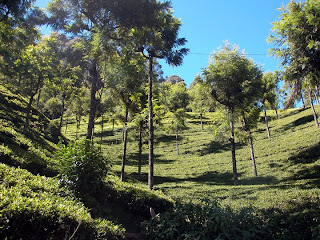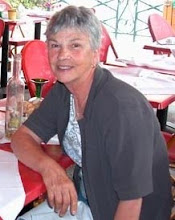On January 23rd the hotel driver took us down the mountains from Ooty to Mysore. It was an enjoyable drive with lovely scenery. There were many switchbacks, but the weather was perfect, the road was good, and the traffic was light. When we completed the descent, we passed through a game preserve and were disappointed when no elephants appeared.
Mysore is a lovely city with many trees and buildings dating from the days of the Maharajas. Wealthy rulers of the most prosperous princely state apart from Hyderabad, the Maharajas were great patrons of the arts and architecture, and created many palaces, churches, temples and gardens. Although Mysore joined India at independence, this legacy of the Maharajas is still very much in evidence today.

Beautiful Downtown Building, Mysore

Jaganmohan Palace, Mysore
Our hotel, the Pai Vista, was a modern four-star hotel with several restaurants and coffee shops. One of the restaurants, the Jungle, was decorated to resemble the jungle at night. It captured the atmosphere perfectly: there were trees, flowers, birds, animals, areas of darkness, areas with spot lights, waiters dressed in safari suits, and the night sounds of the jungle. Combined with fine food, it all made for a great dining experience.
On January 24th we visited Mysore Palace, built by the Maharaja in 1912 to replace the 14th Century structure that was destroyed by fire in 1897. We had a guide show us through the palace. Much of the layout and design of the original were retained. Of its many attractive features the most outstanding were the many doors beautifully carved from Burmese teak, the two beautiful durbar halls for the Maharaja's public audiences and private meetings, and the large ground floor pavilion with the ceiling made from Belgian crystal and its huge crystal chandeliers from Bohemia.

Entrance to Mysore Palace

Temple in Grounds of Mysore Palace

Mysore Palace - No photos allowed of the Interior

Looking Back Towards the Entrance to Mysore Palace
The next day we took a rickshaw to Tipu Sultan's summer palace at Srirangapatna. The palace itself was not that interesting, having become somewhat dilapidated since Tipu's defeat by the British in the late 18th Century. He was a Muslim ruler of Mysore allied with the French who were established in Pondicherry. He fought four major battles until his final defeat - attributed by some observers to his ally, France's, lack of interest due to a preoccupation with what was going on during the French revolution. Still, it was fascinating to be there and to imagine the events that had taken place and were illustrated in the many drawings and paintings in the palace.

Entering the Grounds of Tipu Sultan's Summer Palace at Srirangapatna

The Grounds of Tipu Sultan's Summer Palace

Our Guide Explaining Details of Tipu Sultan's Career

The Summer Palace

Visitors Leaving the Summer Palace
After leaving the summer palace, our driver took us to Tipu's
fort This was huge. An entire village had sprung up inside the
ramparts. We stopped to see the temple but didn't go in. Tipu's tomb, a
miniature Taj Mahal, was lovely, and the small prison was interesting.
British soldiers had been held here, many dying in captivity, no doubt
because they were forced to stand upright for 22 hours each day for four
years in water up to their chins, being allowed to sleep only for the
two remaining hours.
Next morning we visited the Lallitha Mahal Palace, a five star hotel, formerly one of the palaces of the Maharaja of Mysore. Built by the Maharaja in 1921 for the exclusive use of the Viceroy of India, it is one of the most beautiful buildings we have ever seen. Subsequently used as a guest house for the Maharaja's European guests, it became a luxury hotel in 1974. We spent several hours there, enjoying a beautiful lunch in the main restaurant to the accompaniment of a drummer and a flautist. The hotel is elegant, with beautiful decoration and furnishings. We especially admired the elephant at the hotel entrance which is made from intricately inlaid wood.

Lalitha Mahal Palace Hotel, Mysore

Staircase in Lalitha Palace Hotel
Next morning we visited the Lallitha Mahal Palace, a five star hotel, formerly one of the palaces of the Maharaja of Mysore. Built by the Maharaja in 1921 for the exclusive use of the Viceroy of India, it is one of the most beautiful buildings we have ever seen. Subsequently used as a guest house for the Maharaja's European guests, it became a luxury hotel in 1974. We spent several hours there, enjoying a beautiful lunch in the main restaurant to the accompaniment of a drummer and a flautist. The hotel is elegant, with beautiful decoration and furnishings. We especially admired the elephant at the hotel entrance which is made from intricately inlaid wood.

Lalitha Mahal Palace Hotel, Mysore

Staircase in Lalitha Palace Hotel

Dining Room in Lalitha Palace

Wooden Inlay Elephant in Entrance Hall, Lalitha Palace
Being Republic Day, the national holiday of India, we anticipated major celebrations in the city and hoped to see a performance of classical Indian dance. However, the only such performance we discovered was scheduled for late in the afternoon at an auditorium at the University of Mysore. We arrived early and took seats a few rows from the front. About an hour before the concert was to begin, two male and two female singers, seated on the floor of the stage and accompanied by two drums and a keyboard, begin to perform. As it was early and there were not many people in the audience, it seemed likely that this was a prelude to the real concert. Soon, a man came up, whispering to us, and asking if we would please move to the front row, as we were his guests. We agreed, although we felt a bit nonplussed at being singled out in this way and hoped that no role was being planned for us in the subsequent proceedings.
We enjoyed the music, although both the singing and the rhythm were strange. It was complex, with different tunes and rhythms going on simultaneously, but somehow it all came together very well. After about 45 minutes, dignitaries arrived and were seated at a table on the stage, the musical performers remaining seated on the floor at the front.

Musical Performance, Republic Day, Mysore University
The first speaker, who had to be a politician, ranted on at top
volume for about half an hour. He punctuated his rants with an
interminable series of what sounded like rhetorical questions,
aggressively pointing his finger at the audience. We we sat front row
centre, trying to avoid eye contact. The audience, mainly school
children, completely ignored him and continued to talk and laugh the
entire time. While this was going on, the musicians who had been
crouching at the front of the stage got up and left. When the politician
finally finished, we were dismayed to see that he was to being followed
by another,almost equally obnoxious. After five minutes we could stand
it no longer and left the auditorium feeling a bit sheepish because our
behaviour, though necessary for our sanity, would most likely be seen
as hardly worthy of honoured guests. We wondered how many votes the
politicians figured their ranting would gain them considering that the
audience was made up almost entirely of children. We were disappointed
to miss the concert, however, especially since we assumed that the
performers would be the beautiful children who were now filling up the
auditorium dressed in fancy colour-coordinated costumes.

Beautifully dressed school children at the Republic Day celebration
Back to our hotel we went to collect our luggage, then on to
the station for an overnight train to Mangalore. After an uneventful
night, we spent an enjoyable hour or so next morning talking to the
young Indian couple who shared our compartment. They were living in
Seattle where they worked for Amazon. After traveling around India they
were going to see the girl's parents in Dubai. They told us that over
200 graduates of the University of Western Ontario worked for Amazon in
Seattle.
On January 27th, we took an auto rickshaw to go to Sultan’s Battery, a watchtower built by Tipu Sultan. It is located on the Cauvery River, and enabled Tipu to watch for boats approaching on the river. He is said to have built the tower with stones taken from the churches that he destroyed during his 15-year imprisonment of Mangalore’s Christians.

Tipu Sultan's Battery, Mangalore
We then drove to the beach which was quite beautiful. There were at least 50 people wading and swimming. Our driver told us that none of these people could possibly be local because the danger of the undertow here was so well-known by everyone in Managlore. He said that each year many people drowned.

Beach near Mangalore

Portable Temple at the Beach near Mangalore
We then drove through an area of heavy industry, interesting because it was the first we had seen in India.

While in Managlore, we had two splurge lunches at the Taj Hotel. Our hotel was a modern business hotel, plain with very ordinary food.

Taj Hotel, Mangalore
Managlore was a large city that we found quite boring after the excitement of the past few days. It was necessary to visit because it was on the way to Goa. On January 28th at around 3:00 p.m. we left Mangalore for a six-hour train ride to Madgaon.
On January 27th, we took an auto rickshaw to go to Sultan’s Battery, a watchtower built by Tipu Sultan. It is located on the Cauvery River, and enabled Tipu to watch for boats approaching on the river. He is said to have built the tower with stones taken from the churches that he destroyed during his 15-year imprisonment of Mangalore’s Christians.

Tipu Sultan's Battery, Mangalore
We then drove to the beach which was quite beautiful. There were at least 50 people wading and swimming. Our driver told us that none of these people could possibly be local because the danger of the undertow here was so well-known by everyone in Managlore. He said that each year many people drowned.

Beach near Mangalore

Portable Temple at the Beach near Mangalore
We then drove through an area of heavy industry, interesting because it was the first we had seen in India.

While in Managlore, we had two splurge lunches at the Taj Hotel. Our hotel was a modern business hotel, plain with very ordinary food.

Taj Hotel, Mangalore
Managlore was a large city that we found quite boring after the excitement of the past few days. It was necessary to visit because it was on the way to Goa. On January 28th at around 3:00 p.m. we left Mangalore for a six-hour train ride to Madgaon.

Shops and Apartments, Mangalore




































